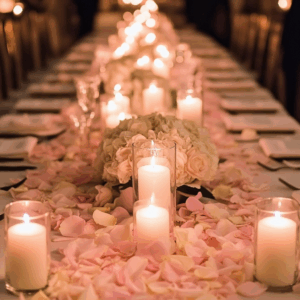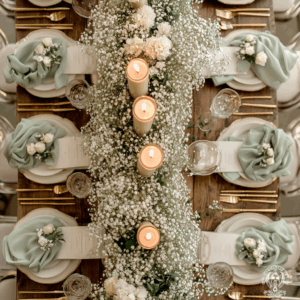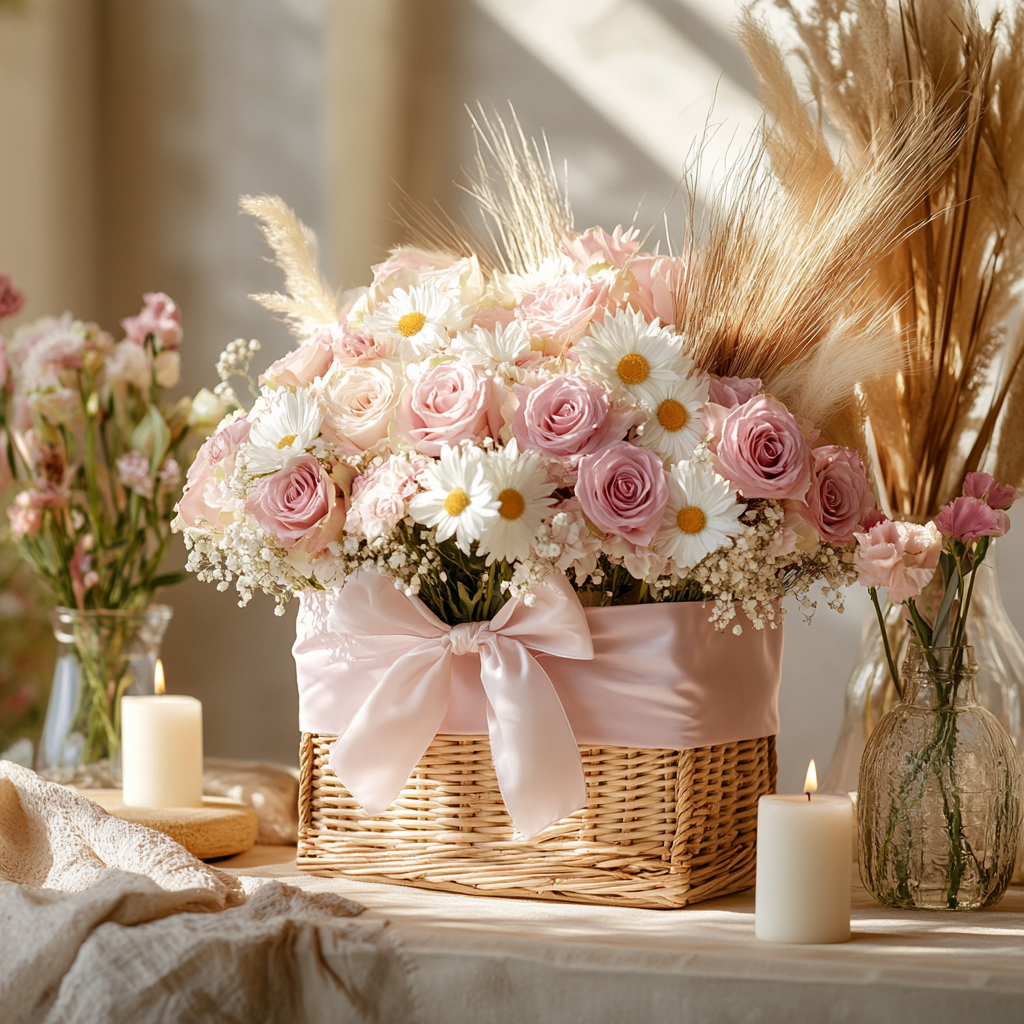When it comes to planning the perfect wedding dinner, the tables play a starring role in setting the mood and enhancing the overall ambiance. One of the most delightful ways to elevate your wedding dinner tables is through elegant centerpieces that capture the essence of your celebration. These focal points not only add beauty but also invite guests to linger, converse, and savor the moment. As you embark on the journey of selecting the ideal centerpiece, consider how each element can harmonize with your wedding theme, color palette, and personal style.
Floral arrangements have long been a classic choice for wedding centerpieces, and for good reason. Their natural beauty and versatility make them a timeless option. To infuse elegance, think beyond traditional bouquets and explore unique combinations of blooms. Soft, romantic flowers like peonies, garden roses, and ranunculus can create a lush, dreamy effect, especially when paired with delicate greenery such as eucalyptus or dusty miller. For a modern twist, consider incorporating unexpected elements like orchids or anemones, which add a touch of sophistication and intrigue. Arranging these flowers in vintage-inspired vases or sleek glass containers can further enhance their charm, blending tradition with contemporary flair.
elegance, think beyond traditional bouquets and explore unique combinations of blooms. Soft, romantic flowers like peonies, garden roses, and ranunculus can create a lush, dreamy effect, especially when paired with delicate greenery such as eucalyptus or dusty miller. For a modern twist, consider incorporating unexpected elements like orchids or anemones, which add a touch of sophistication and intrigue. Arranging these flowers in vintage-inspired vases or sleek glass containers can further enhance their charm, blending tradition with contemporary flair.
However, elegance doesn’t have to be confined to flowers alone. Candles are another wonderful way to bring warmth and intimacy to your tables. Imagine clusters of varying heights, from tall taper candles in elegant holders to small votives scattered around, casting a soft, flickering glow. This gentle illumination not only complements the floral arrangements but also creates a cozy atmosphere that encourages heartfelt conversations. For an added layer of refinement, consider using candle holders made of brass, crystal, or mirrored surfaces, which reflect light beautifully and add a subtle sparkle to the setting.
In addition to flowers and candles, incorporating natural elements can lend a sophisticated yet organic feel to your centerpieces. Think of arrangements featuring succulents nestled among moss or delicate branches adorned with tiny fairy lights. These touches bring texture and depth to the table, offering a fresh alternative to more traditional designs. Moreover, they can be tailored to suit various wedding styles, from rustic chic to modern minimalism, making them incredibly versatile.
Another creative idea is to personalize your centerpieces with meaningful objects that tell your love story. For instance, vintage books stacked beneath a small floral arrangement can evoke a sense of nostalgia and intellectual charm, especially if literature holds a special place in your relationship. Alternatively, incorporating framed photos, delicate keepsakes, or even small sculptures can transform your tables into intimate galleries that celebrate your journey together. This approach not only adds elegance but also invites guests to connect with your story on a deeper level.
As you finalize your centerpiece choices, remember that balance is key. The arrangements should be visually striking without overwhelming the table or obstructing guests’ views. Opt for designs that complement the size and shape of your tables, ensuring there is ample space for dinnerware and comfortable seating. Additionally, consider the practical aspects, such as the longevity of fresh flowers throughout the evening or the safety of open flames if children are present.
Ultimately, elegant centerpieces are about creating an inviting and memorable atmosphere that reflects your unique style and the joy of your wedding day. Whether you lean towards classic florals, glowing candles, natural textures, or personalized touches, the right centerpiece can transform your wedding dinner tables into stunning works of art. By thoughtfully blending beauty, meaning, and functionality, you’ll set the stage for a celebration that your guests will cherish long after the last toast has been made.
How to Create a Seating Chart That Enhances Guest Experience
Creating a seating chart for a wedding dinner is much more than simply assigning seats; it’s an art that can significantly enhance the overall guest experience. When thoughtfully planned, a seating arrangement encourages conversation, fosters new connections, and ensures everyone feels comfortable and included. To begin, it’s important to consider the personalities and relationships of your guests. Grouping people who share common interests or backgrounds can spark lively discussions and laughter, making the evening more enjoyable for everyone. For instance, placing old friends together can rekindle cherished memories, while mixing acquaintances with mutual hobbies can create fresh bonds that last beyond the wedding day.
planned, a seating arrangement encourages conversation, fosters new connections, and ensures everyone feels comfortable and included. To begin, it’s important to consider the personalities and relationships of your guests. Grouping people who share common interests or backgrounds can spark lively discussions and laughter, making the evening more enjoyable for everyone. For instance, placing old friends together can rekindle cherished memories, while mixing acquaintances with mutual hobbies can create fresh bonds that last beyond the wedding day.
Once you have a sense of who might enjoy sitting together, it’s helpful to visualize the layout of your tables. Round tables often promote inclusivity, allowing guests to easily engage with multiple people, whereas long banquet-style tables can create a more formal atmosphere. Depending on the size and shape of your venue, you might choose a combination of both to suit different groups. Additionally, consider the flow of the room; guests should be able to move comfortably without feeling cramped or isolated. Positioning tables near the dance floor or buffet can encourage mingling, while quieter corners might be reserved for those who prefer more intimate conversations.
Another key aspect is balancing the mix of guests at each table. While it’s tempting to seat everyone with their closest friends or family, introducing a few new faces can add excitement and variety to the evening. However, be mindful of potential conflicts or sensitive dynamics. If there are guests who may not get along, it’s best to seat them apart to maintain a harmonious atmosphere. On the other hand, placing shy or less familiar guests with more outgoing individuals can help break the ice and make them feel more at ease.
Incorporating thoughtful details into your seating chart can also elevate the guest experience. Personalized place cards, for example, not only guide guests to their seats but also make them feel special and welcomed. You might include a small note or a fun fact about each guest to spark conversation. Furthermore, coordinating the seating with the overall theme and décor of the wedding adds a cohesive touch that guests will appreciate. Whether it’s elegant calligraphy on the cards or creative table names inspired by shared memories or favorite places, these little touches show care and attention to detail.
As you finalize your seating chart, don’t forget to communicate clearly with your venue and catering team. Providing them with an accurate and easy-to-read layout ensures smooth service and helps avoid any confusion during the event. It’s also wise to have a few flexible seats or a plan for last-minute changes, as unexpected guests or cancellations can occur. Being prepared allows you to adapt without stress, keeping the focus on creating a joyful and seamless experience for everyone.
Ultimately, a well-crafted seating chart is a powerful tool that transforms a wedding dinner from a simple meal into a memorable celebration. By thoughtfully considering relationships, table arrangements, and personal touches, you create an environment where guests feel connected and valued. This careful planning not only enhances the atmosphere but also leaves a lasting impression, making your special day even more meaningful for all who attend.
Tips for Coordinating Table Settings with Your Wedding Theme
When it comes to planning a wedding dinner, one of the most delightful yet intricate details to consider is how your table settings will harmonize with your overall wedding theme. After all, the tables are more than just places for guests to sit and eat; they are a canvas that reflects your style, personality, and the atmosphere you want to create on your special day. Coordinating your table settings with your wedding theme can elevate the entire experience, making it feel cohesive and thoughtfully curated. To begin with, it’s essential to have a clear vision of your wedding theme. Whether you’re drawn to a rustic countryside charm, a glamorous vintage affair, or a modern minimalist celebration, your table settings should echo those vibes. For example, if your theme is rustic, think about incorporating natural elements like wooden chargers, burlap runners, and wildflower centerpieces. These details not only complement the theme but also invite guests to feel the warmth and simplicity of the countryside. On the other hand, a vintage theme might call for delicate lace tablecloths, antique silverware, and pastel-colored glassware that evoke a sense of nostalgia and elegance. Once you have your theme in mind, consider the color palette as the next crucial step. Colors have a powerful way of tying everything together, so choose hues that resonate with your theme and create a pleasing visual flow. If your wedding colors are soft blush and gold, for instance, you might opt for gold-rimmed plates, blush napkins, and subtle floral arrangements that incorporate those shades. This thoughtful coordination ensures that every element on the table feels intentional and harmonious. Another tip is to pay attention to the textures and materials you use. Mixing and matching textures can add depth and interest to your table settings without overwhelming the overall look. For a beach-themed wedding, pairing smooth glassware with woven placemats and linen napkins can evoke the feeling of sand, sea, and breeze. Meanwhile, a glamorous wedding might benefit from the shimmer of sequined table runners combined with sleek metallic accents. Don’t forget the importance of lighting when planning your tables. Candles, fairy lights, or lanterns can create a magical ambiance that complements your theme beautifully. Soft, warm lighting can make rustic or vintage settings feel cozy and inviting, while crisp, bright lighting might suit a modern or urban theme better. Incorporating personalized touches is another wonderful way to connect your table settings to your wedding theme. Custom name cards, themed menu designs, or small favors that reflect your story as a couple can make guests feel special and add a layer of meaning to the décor. For example, if you’re having a travel-themed wedding, place cards shaped like vintage luggage tags or menus designed as boarding passes can be charming and memorable. It’s also wise to think about the scale and arrangement of your centerpieces in relation to your theme and the size of your tables. Large, elaborate centerpieces might overwhelm smaller tables or obstruct guests’ views, while smaller, more delicate arrangements can enhance intimacy and conversation. For a garden-themed wedding, low floral arrangements with greenery can create a fresh and natural look without dominating the table space. Lastly, don’t hesitate to seek inspiration from various sources such as wedding magazines, Pinterest boards, or even nature itself. Sometimes, the perfect idea for coordinating your table settings with your theme comes from an unexpected place. Remember, the goal is to create a seamless experience where every detail feels connected and thoughtfully chosen. By keeping your theme at the heart of your decisions, paying attention to color, texture, lighting, personalization, and scale, you’ll craft table settings that not only look stunning but also tell the story of your wedding day in a beautiful and inviting way.
Conclusion
Effective wedding dinner and table planning ensures a smooth flow of the event, maximizes guest comfort, and enhances social interaction. Thoughtful arrangement of seating promotes inclusivity and enjoyment, while careful menu selection caters to diverse preferences. Overall, meticulous planning creates a memorable dining experience that complements the celebration.
